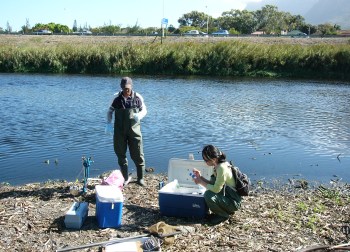| Global Problem | Mercury pollution is a world-wide problem requiring attention at global, regional and national levels |
| Atmospheric mercury cycling and water solubility | Various antropogenic activities release mercury into the atmosphere. This mercury is released as both elemental and oxidized forms.It can travel considerable distances and is removed from the atmosphere by both dry and wet deposition (oxidized mercury is particularly soluble in water) onto land, freshwater and marine resources. Mercury can also be washed off the land (via runoff) into local water resources. |
| Mercury toxicity |  All of the above forms of mercury exhibit neurotoxic effects in humans. This is particularly problematic in children and developing foetuses. |
| Few local mercury impact studies | The nature and extent of mercury pollution and its impacts in South Africa have not been extensively studied. Most studies have been in reaction to emergency incidents relating to mercury. The effluent spill into the Mngcewni River in KwaZulu-Natal during the late 1990's is one example. As a result of that pollution, it was recommended that consumption of fish by local communities be significantly reduced. |
| SA reportedly second worst mercury polluter | In 2006 it was reported that mercury emissions in South Africa were second only to China, contributing more than 10% of global mercury emissions. This was reportedly mainly from coal combustion (releasing the mercury that occurs naturally in coal) and gold mining. Some doubt exists about the validity of these figures, and a more detailed national study is reuired to clarify this. |
| Reservoir effect | Methylmercury formation can also be enhanced when large dams are constructed (known as the "reservoir effect"). The effects can remain for up to 25 years in, for example, fish with high methylmercury levels. Large dams in South Africa provide most of the water for drinking and for energy generation. Many are also used for recreational and subsistence fishing. High mercury levels have been found in catfish cultured with water from the Krugersdrift Dam in Bloemfontein. |
| Artisanal gold mining | Small-scale artisanal gold mining in southern Africa )and in the rest of Africa) is also of concern. Gold extraction relies on amalgamating the gold with liquid mercury. This process results in much mercury being released into the environment. This technique is still used in certain areas in South Africa, the extent of which, and their associated impacts, are unknown. |
| Fossil fuel combustion and waste incineration | Combustion of fossil fuels and the incineration of waste materials are estimated to account for 70% of the total mercury in the atmosphere from global human activities. Average mercury levels in South African coals are equivalent to the global average (-0.2 ppm). With 75% of South Africa's primary energy needs being satisfied by coal and more than 90% of our electricity derived from coal-fired power stations, coal combustion may be a significant source of mercury emissions. Measurements to assess the extent to which fossil fuel combustion or waste incineration contributes to mercury releases and impacts to the environment are needed throughout South Africa. |
| Household coal combustion | A significant amount of coal is also burned for cooking and heating in poorer households in South Africa. This increases in winter with concomitant increases in atmospheric particulates (and associated mercury). This has also been observed in other developing countries although it has not been extensively studies in South Africa. The mercury-related impacts (particularly on human health) from this source are also unknown. Cleaner technologies are required fro cooking and heating in poorer households and require further investigation. |

